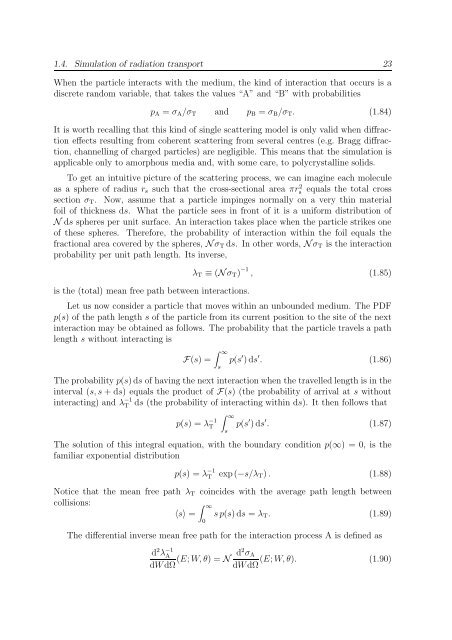PENELOPE 2003 - OECD Nuclear Energy Agency
PENELOPE 2003 - OECD Nuclear Energy Agency
PENELOPE 2003 - OECD Nuclear Energy Agency
You also want an ePaper? Increase the reach of your titles
YUMPU automatically turns print PDFs into web optimized ePapers that Google loves.
1.4. Simulation of radiation transport 23<br />
When the particle interacts with the medium, the kind of interaction that occurs is a<br />
discrete random variable, that takes the values “A” and “B” with probabilities<br />
p A = σ A /σ T and p B = σ B /σ T . (1.84)<br />
It is worth recalling that this kind of single scattering model is only valid when diffraction<br />
effects resulting from coherent scattering from several centres (e.g. Bragg diffraction,<br />
channelling of charged particles) are negligible. This means that the simulation is<br />
applicable only to amorphous media and, with some care, to polycrystalline solids.<br />
To get an intuitive picture of the scattering process, we can imagine each molecule<br />
as a sphere of radius r s such that the cross-sectional area πrs<br />
2 equals the total cross<br />
section σ T . Now, assume that a particle impinges normally on a very thin material<br />
foil of thickness ds. What the particle sees in front of it is a uniform distribution of<br />
N ds spheres per unit surface. An interaction takes place when the particle strikes one<br />
of these spheres. Therefore, the probability of interaction within the foil equals the<br />
fractional area covered by the spheres, N σ T ds. In other words, N σ T is the interaction<br />
probability per unit path length. Its inverse,<br />
is the (total) mean free path between interactions.<br />
λ T ≡ (N σ T ) −1 , (1.85)<br />
Let us now consider a particle that moves within an unbounded medium. The PDF<br />
p(s) of the path length s of the particle from its current position to the site of the next<br />
interaction may be obtained as follows. The probability that the particle travels a path<br />
length s without interacting is<br />
F(s) =<br />
∫ ∞<br />
s<br />
p(s ′ ) ds ′ . (1.86)<br />
The probability p(s) ds of having the next interaction when the travelled length is in the<br />
interval (s, s + ds) equals the product of F(s) (the probability of arrival at s without<br />
interacting) and λ −1<br />
T ds (the probability of interacting within ds). It then follows that<br />
p(s) = λ −1<br />
T<br />
∫ ∞<br />
s<br />
p(s ′ ) ds ′ . (1.87)<br />
The solution of this integral equation, with the boundary condition p(∞) = 0, is the<br />
familiar exponential distribution<br />
p(s) = λ −1<br />
T exp (−s/λ T ) . (1.88)<br />
Notice that the mean free path λ T coincides with the average path length between<br />
collisions:<br />
∫ ∞<br />
〈s〉 = s p(s) ds = λ T . (1.89)<br />
0<br />
The differential inverse mean free path for the interaction process A is defined as<br />
d 2 λ −1<br />
A<br />
dW dΩ (E; W, θ) = N d2 σ A<br />
(E; W, θ). (1.90)<br />
dW dΩ
















